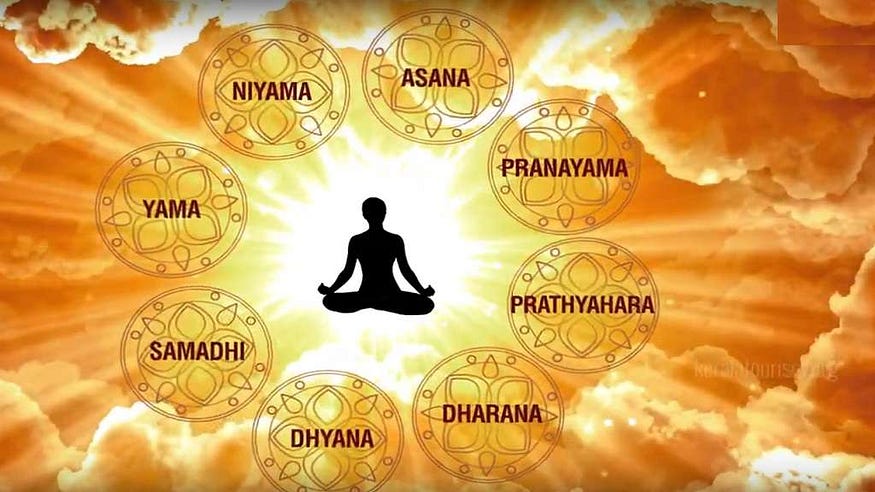Hatha in Sanskrit literally means ‘stubborn’. It is a preparatory process of Yoga. The word “ha” means sun, “ta” means moon. “Hatha” means the Yoga to bring balance between the sun and the moon in you, or the Pingala and Ida in you.

Hatha Yoga practice means the stubborn practice of yoga, without the interference of the five senses and the mind. Generally, some people think of Hatha Yoga only as asana practice. But it is the austere practice of asana, pranayama, dharana, and dhyana to achieve the sublime state of samadhi. In samadhi the yogi becomes free from the illusion of form, time, and space. Asana is just one of the six practices in this path.
Hatha Yoga originates from Raja Yoga. It is the simpler version (without Yamas and Niyamas) of Raja Yoga. In simple words, you can say all the yoga poses and pranayama exercises can be classified as Hatha Yoga. So if you practice any yoga asanas or pranayama exercises you are practicing Hatha.
History of Hatha Yoga
Around the early 15th century, some yogis from the Natha lineage did not want to began practicing asanas before mastering Yama and Niyamas. As the mind was not ready for further practice they had to work harder. They called it their ‘stubborn’ practice of Yoga. These Natha Yogis kept practicing the asanas until they mastered them. This way of practicing Raja Yoga, not following the strict order of first mastering Yamas and Niyamas, was named ‘Hatha Yoga‘.
A 15th-century sage Swami Swatmarama ,compiled Hatha Yoga Pradipika and briefly described six limbs of yoga to achieve Samadhi without the long process of the first two steps of the Yamas and Niyamas. Hatha Yoga is also known as Ashatanga Yoga (eight limb yoga).

According to Patanjali’s Yoga Sutras, the eight limbs of the path of Hatha yoga are:
- Yamas — Five social observances: ahimsa (non-violence), satya (truthfulness) asteya (non-stealing), brahmacharya (chastity) and aparigraha (non-possessiveness).
- Niyamas — Five moral observances: saucha (purity), santosha (contentment), tapas (self-discipline), svadhyaya (self-study), ishvarapranidhana (devotion or surrender).
- Asana — Yoga postures.
- Pranayama — Breathing techniques as a means of controlling prana (vital life force energy).
- Pratyahara — Withdrawal of the senses.
- Dharana — Concentration.
- Dhyana — Meditation.
- Samadhi — Enlightenment or bliss.
Benefits of Hatha Yoga
There are numerous benefits of Hatha Yoga at both Physical level and Mental level . Some of its benefits are as follows:
Physical Benefits
Some of the benefits of Hatha Yoga on the physical body are:
- It improves mobility in the joints.
- It improves flexibility in the connective tissue.
- It stretches the fascia and improves its condition.
- It improves metabolism.
- It improves the functioning of all body systems.
- It stimulates cell repair and regeneration.
- It improves blood flow in the spinal cord and brain.
- It rejuvenates the ligaments.
- It helps to stimulate the lymphatic system and cleanses the body.
- It improves the overall range of motion of the body.
- It improves energy levels.
- It improves the function of the lungs and heart.
- It brings balance to the sympathetic and parasympathetic nervous system.
Mental Benefits
Some of the mental benefits are:
- It helps to calm down the senses.
- It helps to improve concentration.
- It sharpens the focus.
- It brings balance to the emotions.
- It relieves anxiety and depression.
- It removes mental fatigue.
- It stimulates creativity.
- It stimulates learning facilities.
How Hatha Yoga is different from other ?
Hatha Yoga is an ancient yoga practice, there are many differences with other modern yoga styles:
- Asanas are held steady for a duration of 1–5 minutes.
- The metabolism decreases compared to other yoga styles.
- Most of the Asanas focus on internal organs and the spine whereas in other styles focus is on muscle groups and joints.
- Stillness of body and mind is given more importance than movement.
Best Hatha Yoga Poses

There are 84 traditional Hatha Yoga poses. The most popular poses are:
- Shirshasna — Headstand
- Sarvangasana — Shoulderstand
- Halasana- Plough Pose
- Matsyasana — Fish Pose
- Gomukhasana — Cow-Face Pose
- Paschimotthanasna — Seated Forward Bend
- Bhujangasana — Cobra Pose
- Mayurasana — Peacock Pose
- Natrajasana — Dancer’s Pose
- Vrikshasana — Tree Pose


